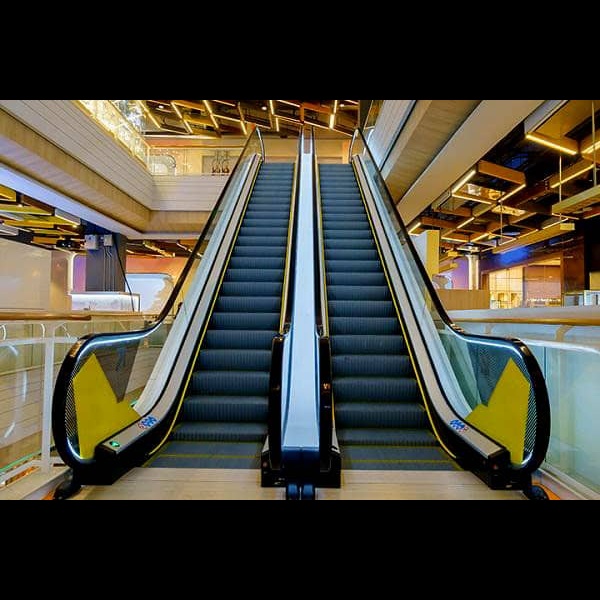About the product
An escalator is a moving staircase that carries people between floors of a building or structure. It consists of a motor-driven chain of individually linked steps on a track that cycle on a pair of tracks that keep them horizontal.
Escalators are often used around the world in places where lifts would be impractical, or they can be used in conjunction with them. Principal areas of usage include department stores, shopping malls, airports, transit systems (railway/railroad stations), convention centers, hotels, arenas, stadiums, and public buildings.
Design, components, and operation
Escalators typically rise at an angle of about 30 degrees from the ground. They move at 0.3–0.6 meters per second (1–2 ft/s) – like moving walkways, and may traverse vertical distances over 18 meters (60 ft). Most modern escalators have single-piece aluminum or stainless steel steps that move on a system of tracks in a continuous loop.
Different types of escalators include
Parallel (up and down escalators adjacent or nearby, often seen in perpendicular areas, metro stations, and multilevel movie theaters)
Multiple parallels (banks of more than one escalator going in the same direction parallel to banks going the other direction)
crisscross (escalators going in one direction "stacked" with escalators going the opposite direction oriented adjacent but perpendicular, frequently used in department stores or shopping centers).
Design and layout considerations
Design factors include physical requirements, location, traffic patterns, safety considerations, and esthetics. Physical factors such as the distance to be spanned determine the length and pitch of the escalator, while factors such as the infrastructure’s ability to provide support and power must be considered. How upward and downward traffic is separated and load/unload areas are other important considerations.
Escalators are often used around the world in places where lifts would be impractical, or they can be used in conjunction with them. Principal areas of usage include department stores, shopping malls, airports, transit systems (railway/railroad stations), convention centers, hotels, arenas, stadiums, and public buildings.
Design, components, and operation
Escalators typically rise at an angle of about 30 degrees from the ground. They move at 0.3–0.6 meters per second (1–2 ft/s) – like moving walkways, and may traverse vertical distances over 18 meters (60 ft). Most modern escalators have single-piece aluminum or stainless steel steps that move on a system of tracks in a continuous loop.
Different types of escalators include
Parallel (up and down escalators adjacent or nearby, often seen in perpendicular areas, metro stations, and multilevel movie theaters)
Multiple parallels (banks of more than one escalator going in the same direction parallel to banks going the other direction)
crisscross (escalators going in one direction "stacked" with escalators going the opposite direction oriented adjacent but perpendicular, frequently used in department stores or shopping centers).
Design and layout considerations
Design factors include physical requirements, location, traffic patterns, safety considerations, and esthetics. Physical factors such as the distance to be spanned determine the length and pitch of the escalator, while factors such as the infrastructure’s ability to provide support and power must be considered. How upward and downward traffic is separated and load/unload areas are other important considerations.
Price
Call Us
Contact with supplier
Company
